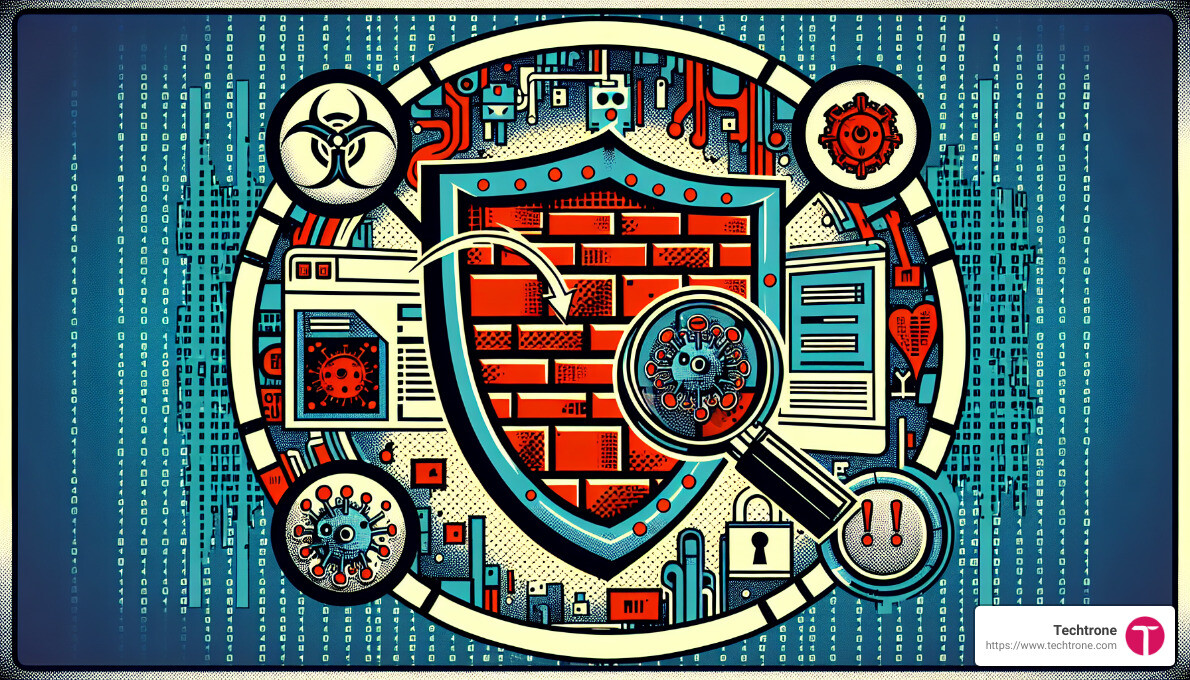Quick Guide: Why You Need Firewall Antivirus Software
- Immediate Protection: Firewalls monitor incoming/outgoing network traffic. Antivirus software protects against malware.
- Strong Defense: Together, they provide a dual layer of security.
- Cost-effective Solution: Combining both is a smart investment in your business’s digital safety.
Keeping your business safe online is not just important, it’s essential. Every day, new cyber threats emerge, targeting small to medium-sized enterprises. These threats are not just annoyances; they can cause serious harm to your business’s operations and reputation. This is where the combination of firewall and antivirus software comes into play, acting as your first line of defense against these digital dangers.
Firewalls work as gatekeepers for your network, deciding who gets in and who stays out based on a set of security rules. Antivirus software, on the other hand, is like a vigilant guard, constantly patrolling inside your digital premises, seeking out and neutralizing threats that manage to slip past your gates. Separately, each has its strengths and weaknesses, but together, they form a powerful duo that significantly enhances your cybersecurity posture.
But why combine both? Simple: cyber threats are evolving. Today’s cybercriminals use sophisticated techniques to bypass traditional security measures. A firewall might stop a hacker from accessing your network, but it won’t catch a virus hidden in an email attachment. Similarly, antivirus can catch that virus but can’t do much if a hacker decides to overwhelm your system with a Denial-of-Service attack. By employing both, you’re creating a comprehensive shield that not only keeps attackers at bay but also safeguards your data from malicious software.
Let’s simplify this concept even further:

In the battle against cyber threats, knowledge, and preparation are your best allies. Keep reading to understand how firewalls and antivirus software work, their differences, and how to implement them effectively within your organization for a robust cybersecurity posture.
Understanding Firewall and Antivirus Software
In cybersecurity, firewall and antivirus software are like the dynamic duo fighting against cybercrime. They each have their unique strengths, and when combined, they provide a powerful defense against a wide array of cyber threats. Let’s dive into the purpose of each, highlight their differences, and explore how they contribute to network and endpoint security.
Purpose
Firewalls act as gatekeepers for your network. Think of a firewall as a bouncer at a club, deciding who gets in and who stays out based on a list of rules. Its primary job is to monitor and control incoming and outgoing network traffic. This control helps to protect your network from unauthorized access and other potential threats from the outside world.
Antivirus software, on the other hand, is like a health inspector for your computer system. It scans, detects, and removes malware and viruses that can infect your system. Antivirus keeps an eye on the files entering your system, ensuring they’re not carrying any malicious threats that could harm your computer’s health.
Differences
The main difference between a firewall and antivirus is where they operate and what they protect against:
- Firewalls work at the network level. They monitor data packets entering or leaving the network, blocking or allowing them based on predefined security rules.
- Antivirus software operates at the endpoint or device level. It focuses on protecting the computer from malware by detecting and removing any malicious software.
Network Security
Network security is about protecting the data traveling across your network. Firewalls play a crucial role here by serving as the first line of defense. They filter out potentially harmful traffic and prevent unauthorized access to your network. By doing so, firewalls help maintain the integrity and confidentiality of your data.
Endpoint Security
Endpoint security is about protecting the devices that connect to your network, like computers, smartphones, and tablets. This is where antivirus software shines. It defends these devices against malware, ransomware, and other viruses that can compromise data and system functionality.
By understanding the roles and differences between firewall and antivirus software, organizations can create a layered defense strategy. This strategy combines network security and endpoint security to protect against a wide range of cyber threats.
We’ll delve into the types of firewalls available and the key features of antivirus software. This information will help you choose the right firewall antivirus software for your needs, ensuring your network and devices are well-protected against cyber threats.
Next, let’s explore the different types of firewalls and how they contribute to securing your network.
Types of Firewalls
In cybersecurity, firewalls act like the gatekeepers of your network, deciding who gets in and who stays out based on a set of rules. Let’s dive into the types of firewalls that play a crucial role in protecting your digital space.
Packet Filtering
Imagine a security guard checking IDs at a party. Packet filtering works similarly by examining small pieces of data (packets) against a set of filters or rules. If the data matches the rules, it’s allowed through; if not, it’s blocked. This is the most basic form of firewall, straightforward but essential for basic network security.
NGFW (Next-Generation Firewalls)
Next up, we have the Next-Generation Firewalls (NGFW). These are the superheroes of the firewall world. Not only do they perform packet filtering, but they also have additional powers like intrusion prevention, deep packet inspection, and the ability to understand the applications sending the packets, not just the port and protocol used. This means they’re smarter and more adaptable, providing a stronger defense against complex attacks.
Application Gateway
Also known as a Proxy Server, the Application Gateway acts like a middleman for requests from clients seeking resources from servers. Think of it as a translator or intermediary who checks the content of the application data, ensuring it’s safe before letting it through. This type of firewall operates at a higher level, offering more detailed control over the traffic and the ability to conceal the identities of the parties involved in the communication.
Circuit Gateway
The Circuit Gateway sets up two connections: one between the client and the firewall, and another between the firewall and the target server. It’s like having a trusted courier deliver your message directly to the recipient and bring back the response without revealing your identity. This type of firewall ensures the integrity and security of the data path and is particularly useful for secure communications.
Each type of firewall has its unique strengths and applications, and the choice depends on the specific needs of your network. Whether it’s the simplicity and directness of packet filtering, the comprehensive protection of NGFWs, the application-level scrutiny of an Application Gateway, or the secure communication channels created by a Circuit Gateway, there’s a firewall solution that fits every security strategy.
By understanding these types of firewalls, you can better appreciate the role they play in a firewall antivirus software solution, providing a robust defense mechanism against a wide range of cyber threats. The goal is to create a secure, resilient network that can withstand the challenges posed by increasingly sophisticated cyber-attacks.
In the next section, we’ll delve into the key features of antivirus software and how it complements the protection offered by firewalls, rounding out your cybersecurity defense strategy.
Key Features of Antivirus Software
When we talk about safeguarding our digital lives, antivirus software plays a pivotal role. Let’s break down the core features that make antivirus software a crucial part of your cybersecurity toolkit.
Signature Detection
Imagine your antivirus software as a detective with a vast database of fingerprints. Each fingerprint corresponds to known malware. This database is what we call signatures. When you download a file or an app, your antivirus checks it against these signatures. If there’s a match, it flags the item as dangerous. It’s a straightforward yet effective way to catch known threats. However, like a detective relying solely on fingerprints, it can miss cleverly disguised or new malware.
Real-Time Scanning
Real-time scanning is your ever-vigilant guard. It monitors your system continuously, checking files as they are accessed or downloaded. This means if you click on a malicious link or download a compromised file, your antivirus is there to stop the threat in its tracks. It’s like having a bodyguard who checks everyone at the door before letting them in.
Malware Removal
Detecting malware is one thing, but removing it safely is another. Antivirus software not only identifies threats but also helps to clean them up. This might involve deleting the file, quarantining it to stop it from causing further harm, or repairing it if possible. Think of it as a doctor who not only diagnoses the illness but also prescribes the treatment to get you back to health.
Proactive Identification
The digital threat landscape is constantly evolving, with new malware emerging daily. Proactive identification, including behavior-based detection and heuristic analysis, allows antivirus software to identify suspicious behavior or characteristics in files that might indicate a new, unknown threat. This is akin to a detective piecing together clues to solve a mystery before the criminal can strike again. It’s about anticipating threats, not just reacting to them.
In Conclusion:
Combining these features, antivirus software provides a comprehensive shield against a variety of digital threats. Signature detection offers a solid defense against known threats, while real-time scanning ensures ongoing vigilance. Malware removal is critical for cleaning up after an infection, and proactive identification keeps you one step ahead of new threats. Together, these features form the cornerstone of any robust cybersecurity strategy, complementing firewall protection and securing your digital world against intrusion.
As we transition into the next section, keep in mind that while antivirus software is powerful on its own, it’s most effective when part of a broader, layered approach to cybersecurity. This holistic strategy is what we’ll explore next, focusing on how to seamlessly integrate firewalls and antivirus software for optimal protection.
Best Practices for Combining Firewalls and Antivirus
In the vast and complex world of cybersecurity, using both firewalls and antivirus software together forms a robust defense system for your digital assets. Let’s dive into the best practices for merging these tools into an effective security strategy.
Holistic Approach
The first step is adopting a holistic view of your cybersecurity needs. Think of your digital environment as a house. A firewall acts like the fence around your property, controlling who can come in or go out, while antivirus software works like a security system inside, detecting and neutralizing any intruders that get through. For comprehensive protection, you need both the fence and the security system working together seamlessly.
Defense-in-Depth
Defense-in-depth is a strategy that layers multiple security measures to protect your data. It’s like having a fence, a security system, and a guard dog. Even if an attacker gets past one defense, another layer will stop them. Combine firewalls to monitor and control access with antivirus software that can detect and remove malware. This layered approach significantly reduces your vulnerability to cyber threats.
Endpoint Security
Endpoints are devices that connect to your network, like computers and smartphones. Each endpoint is a potential entry point for threats. Antivirus software is crucial here, as it protects these devices from malware. But, it’s not just about having antivirus; it’s about keeping it updated. New malware variants are constantly being created, and your antivirus needs the latest updates to recognize and stop them.
Network Boundary Protection
Firewalls are the guardians of your network’s boundary, scrutinizing incoming and outgoing traffic based on predetermined security rules. They block unauthorized access and can prevent data from leaking out. For the best protection, configure your firewall’s rules to match your organization’s specific needs. It’s not a set-it-and-forget-it tool; regular reviews and updates ensure it continues to protect effectively against new threats.
Combining Forces
When integrating firewalls and antivirus software, ensure they’re not just coexisting but actively complementing each other. For instance, some advanced firewalls include antivirus capabilities, scanning incoming traffic for threats before they reach your network. Conversely, some antivirus solutions offer web protection features, blocking malicious websites and downloads, which adds an extra layer of defense at the endpoint level.
Cybersecurity is not just about having the right tools; it’s about using them effectively. Regularly review your security policies, conduct network assessments, and train your staff on best practices. Cyber threats are constantly evolving, but with a well-thought-out strategy that combines firewalls and antivirus software, you can significantly enhance your organization’s security posture.
Keep these practices in mind. They’re not just recommendations; they’re essential steps in building a secure digital environment for your business. Next, we’ll answer some frequently asked questions about firewall antivirus software, clarifying common misconceptions and providing you with the knowledge to make informed decisions about your cybersecurity strategy.
Frequently Asked Questions about Firewall Antivirus Software
When it comes to protecting your digital environment, understanding the tools at your disposal is crucial. Firewall antivirus software plays a significant role in cybersecurity, but there are common questions and misconceptions about its use. Let’s address some of these.
Q: Is a firewall an antivirus software?
Purpose: A firewall acts as a barrier between your computer or network and the internet, controlling incoming and outgoing traffic based on security rules. Its primary purpose is to prevent unauthorized access. On the other hand, antivirus software scans, detects, and removes malicious software and viruses from your computer.
Differences: The key difference lies in their functions. A firewall monitors and controls network traffic, while antivirus software deals with internal threats by identifying and removing malware.
Q: Do I need antivirus if I have Windows Firewall?
Windows Default Antivirus: Windows comes with built-in firewall and antivirus solutions, known as Windows Firewall and Windows Defender, respectively. While these provide a basic level of protection, they may not be sufficient against sophisticated attacks.
Additional Protection: For comprehensive security, it’s advisable to supplement the Windows Firewall with third-party antivirus software. This combination offers enhanced protection by covering a broader range of threats.
Q: What’s the best firewall antivirus?
Criteria: The best firewall antivirus software should offer comprehensive protection, ease of use, and minimal impact on system performance. It should protect against a wide range of threats, including viruses, malware, and unauthorized network access.
Features: Look for software that includes real-time scanning, automatic updates, and the ability to detect and remove threats. Advanced features like sandboxing, vulnerability scanning, and behavior-based detection can offer additional layers of protection.
Protection Level: The highest level of protection is achieved by using a combination of firewall and antivirus that complements each other. Ideally, your chosen software should have a strong track record of detecting both known and emerging threats.
In conclusion, while firewall and antivirus serve different purposes, both are essential components of a robust cybersecurity strategy. Using both in tandem provides a comprehensive defense mechanism against a wide array of digital threats. In the changing landscape of cyber threats, staying informed and prepared is your best defense.
Conclusion
In our journey through the complexities of cybersecurity, we’ve explored the unique roles and strengths of both firewall and antivirus software. These tools, while distinct, are critical to forming a shield against the myriad of cyber threats that businesses face today. At Techtrone, we understand that navigating the digital landscape can be daunting. That’s why we’re committed to providing you with the optimal technology solutions tailored to your specific needs.
Cybersecurity Strategy: The Techtrone Approach
Our approach at Techtrone is not just about deploying tools; it’s about crafting a strategy that encompasses the entire spectrum of your digital environment. We believe in a holistic cybersecurity strategy that integrates both firewall and antivirus software, ensuring that your network and endpoints are fortified against attacks.
-
Defense-in-Depth: We adopt a layered security strategy, recognizing that no single solution can offer 100% protection. By layering firewall and antivirus defenses, we create multiple barriers to deter attackers and safeguard your data.
-
Customized Solutions: Understanding that every business has unique needs, we tailor our cybersecurity solutions to align with your risk profile, operational requirements, and budget constraints. Our goal is to offer you the most effective protection without unnecessary complexity or cost.
-
Proactive Protection: The best defense is a good offense. We don’t just wait for attacks to happen. Our solutions include proactive monitoring, regular updates, and vulnerability assessments to anticipate and neutralize threats before they strike.
-
Education and Support: Knowledge is power. We empower our clients with the knowledge to recognize potential threats and the training to respond effectively. Our support team is always ready to assist, ensuring that you have expert guidance whenever you need it.
Optimal Technology Solutions
Choosing the right firewall antivirus software is crucial, but it’s just one piece of the puzzle. At Techtrone, we go beyond software to offer comprehensive solutions that address all facets of your cybersecurity needs. From securing your network perimeter with advanced firewalls to protecting your endpoints with cutting-edge antivirus technology, we have you covered.
But our commitment doesn’t end there. We understand that technology alone cannot guarantee security. That’s why we emphasize the importance of regular updates, strict access controls, and ongoing employee education. By fostering a culture of cybersecurity awareness, we help you build a resilient defense against both current and emerging threats.
In conclusion, as we navigate the evolving threat landscape, partnering with a trusted cybersecurity provider like Techtrone ensures that your business is equipped with the optimal technology solutions. With our holistic approach, customized strategies, and unwavering support, you can focus on growing your business with the confidence that your digital assets are protected. Together, let’s build a safer digital future.




